Tourism and Society: A Level 4 Essay on Societal Impacts
VerifiedAdded on 2023/06/04
|7
|1973
|185
Essay
AI Summary
This essay delves into the intricate relationship between tourism and society, emphasizing how tourism can both enhance and challenge social structures and cultural values. It explores the tourism lifecycle, highlighting stages from exploration to potential stagnation, and discusses the economic benefits, such as income generation for local communities, alongside potential adverse effects like increased crime and environmental degradation. The essay uses Italy as a case study, examining how government policies and technological advancements influence its tourism sector. Furthermore, it identifies factors influencing tourist behavior, including personal interests, reviews, and external elements like family and cultural values. The conclusion underscores the importance of sustainable tourism practices and responsible management to ensure long-term benefits for both tourists and host communities. This resource is available on Desklib, a platform offering a wide range of academic materials and study tools for students.
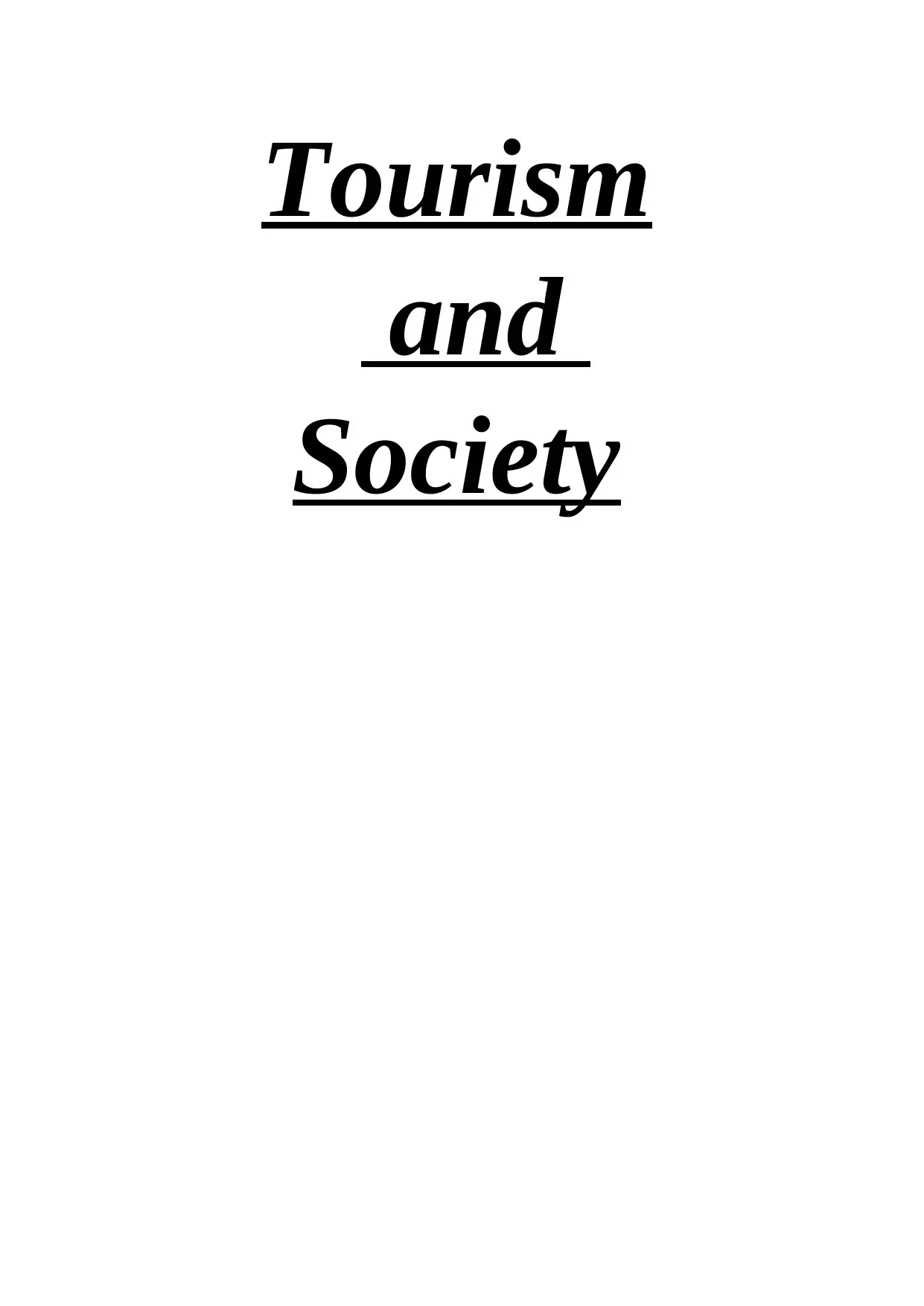
Tourism
and
Society
and
Society
Paraphrase This Document
Need a fresh take? Get an instant paraphrase of this document with our AI Paraphraser

Contents
Introduction................................................................................................................................3
Main Body..................................................................................................................................3
Conclusion..................................................................................................................................5
References..................................................................................................................................6
Introduction................................................................................................................................3
Main Body..................................................................................................................................3
Conclusion..................................................................................................................................5
References..................................................................................................................................6
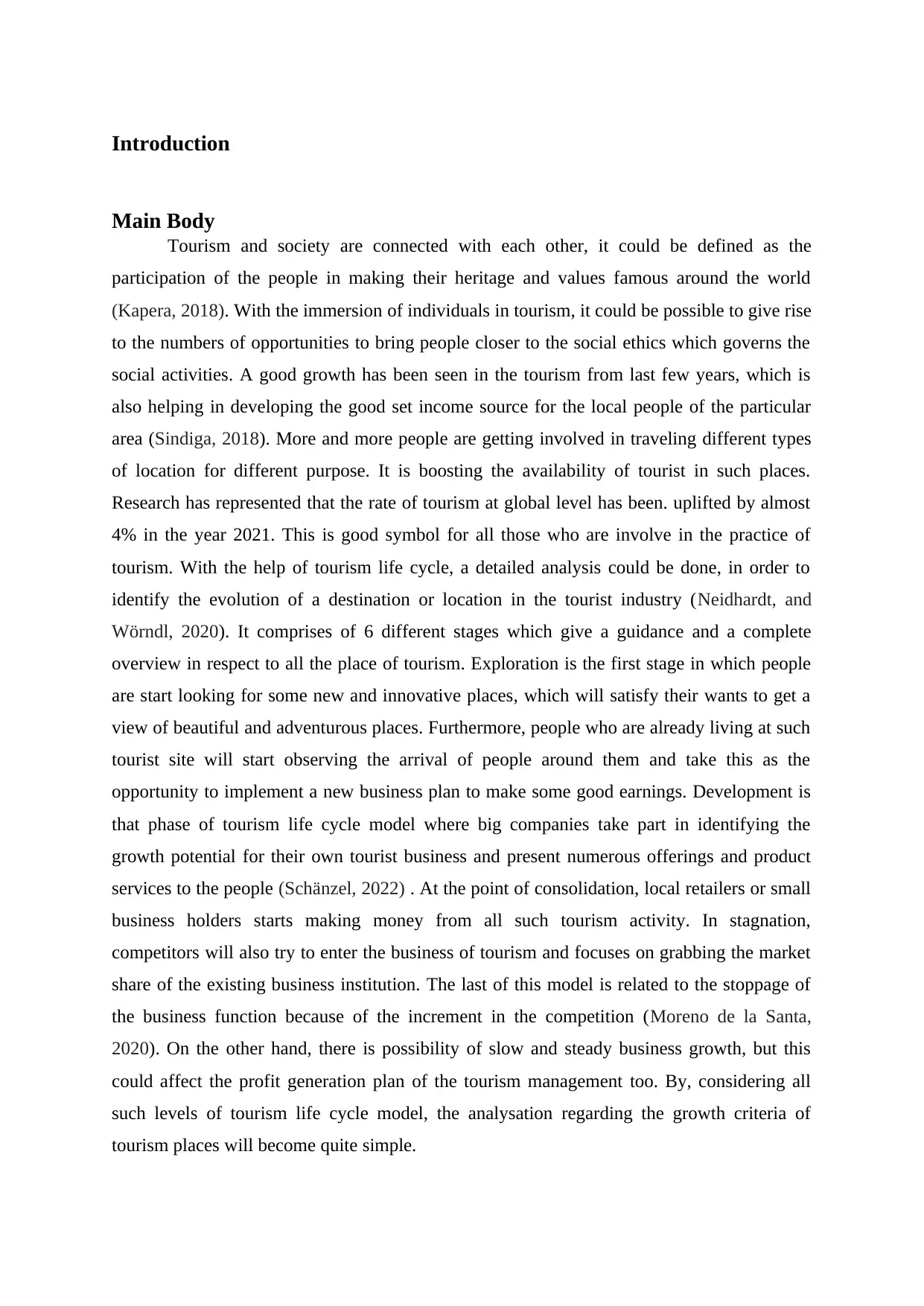
Introduction
Main Body
Tourism and society are connected with each other, it could be defined as the
participation of the people in making their heritage and values famous around the world
(Kapera, 2018). With the immersion of individuals in tourism, it could be possible to give rise
to the numbers of opportunities to bring people closer to the social ethics which governs the
social activities. A good growth has been seen in the tourism from last few years, which is
also helping in developing the good set income source for the local people of the particular
area (Sindiga, 2018). More and more people are getting involved in traveling different types
of location for different purpose. It is boosting the availability of tourist in such places.
Research has represented that the rate of tourism at global level has been. uplifted by almost
4% in the year 2021. This is good symbol for all those who are involve in the practice of
tourism. With the help of tourism life cycle, a detailed analysis could be done, in order to
identify the evolution of a destination or location in the tourist industry (Neidhardt, and
Wörndl, 2020). It comprises of 6 different stages which give a guidance and a complete
overview in respect to all the place of tourism. Exploration is the first stage in which people
are start looking for some new and innovative places, which will satisfy their wants to get a
view of beautiful and adventurous places. Furthermore, people who are already living at such
tourist site will start observing the arrival of people around them and take this as the
opportunity to implement a new business plan to make some good earnings. Development is
that phase of tourism life cycle model where big companies take part in identifying the
growth potential for their own tourist business and present numerous offerings and product
services to the people (Schänzel, 2022) . At the point of consolidation, local retailers or small
business holders starts making money from all such tourism activity. In stagnation,
competitors will also try to enter the business of tourism and focuses on grabbing the market
share of the existing business institution. The last of this model is related to the stoppage of
the business function because of the increment in the competition (Moreno de la Santa,
2020). On the other hand, there is possibility of slow and steady business growth, but this
could affect the profit generation plan of the tourism management too. By, considering all
such levels of tourism life cycle model, the analysation regarding the growth criteria of
tourism places will become quite simple.
Main Body
Tourism and society are connected with each other, it could be defined as the
participation of the people in making their heritage and values famous around the world
(Kapera, 2018). With the immersion of individuals in tourism, it could be possible to give rise
to the numbers of opportunities to bring people closer to the social ethics which governs the
social activities. A good growth has been seen in the tourism from last few years, which is
also helping in developing the good set income source for the local people of the particular
area (Sindiga, 2018). More and more people are getting involved in traveling different types
of location for different purpose. It is boosting the availability of tourist in such places.
Research has represented that the rate of tourism at global level has been. uplifted by almost
4% in the year 2021. This is good symbol for all those who are involve in the practice of
tourism. With the help of tourism life cycle, a detailed analysis could be done, in order to
identify the evolution of a destination or location in the tourist industry (Neidhardt, and
Wörndl, 2020). It comprises of 6 different stages which give a guidance and a complete
overview in respect to all the place of tourism. Exploration is the first stage in which people
are start looking for some new and innovative places, which will satisfy their wants to get a
view of beautiful and adventurous places. Furthermore, people who are already living at such
tourist site will start observing the arrival of people around them and take this as the
opportunity to implement a new business plan to make some good earnings. Development is
that phase of tourism life cycle model where big companies take part in identifying the
growth potential for their own tourist business and present numerous offerings and product
services to the people (Schänzel, 2022) . At the point of consolidation, local retailers or small
business holders starts making money from all such tourism activity. In stagnation,
competitors will also try to enter the business of tourism and focuses on grabbing the market
share of the existing business institution. The last of this model is related to the stoppage of
the business function because of the increment in the competition (Moreno de la Santa,
2020). On the other hand, there is possibility of slow and steady business growth, but this
could affect the profit generation plan of the tourism management too. By, considering all
such levels of tourism life cycle model, the analysation regarding the growth criteria of
tourism places will become quite simple.
⊘ This is a preview!⊘
Do you want full access?
Subscribe today to unlock all pages.

Trusted by 1+ million students worldwide
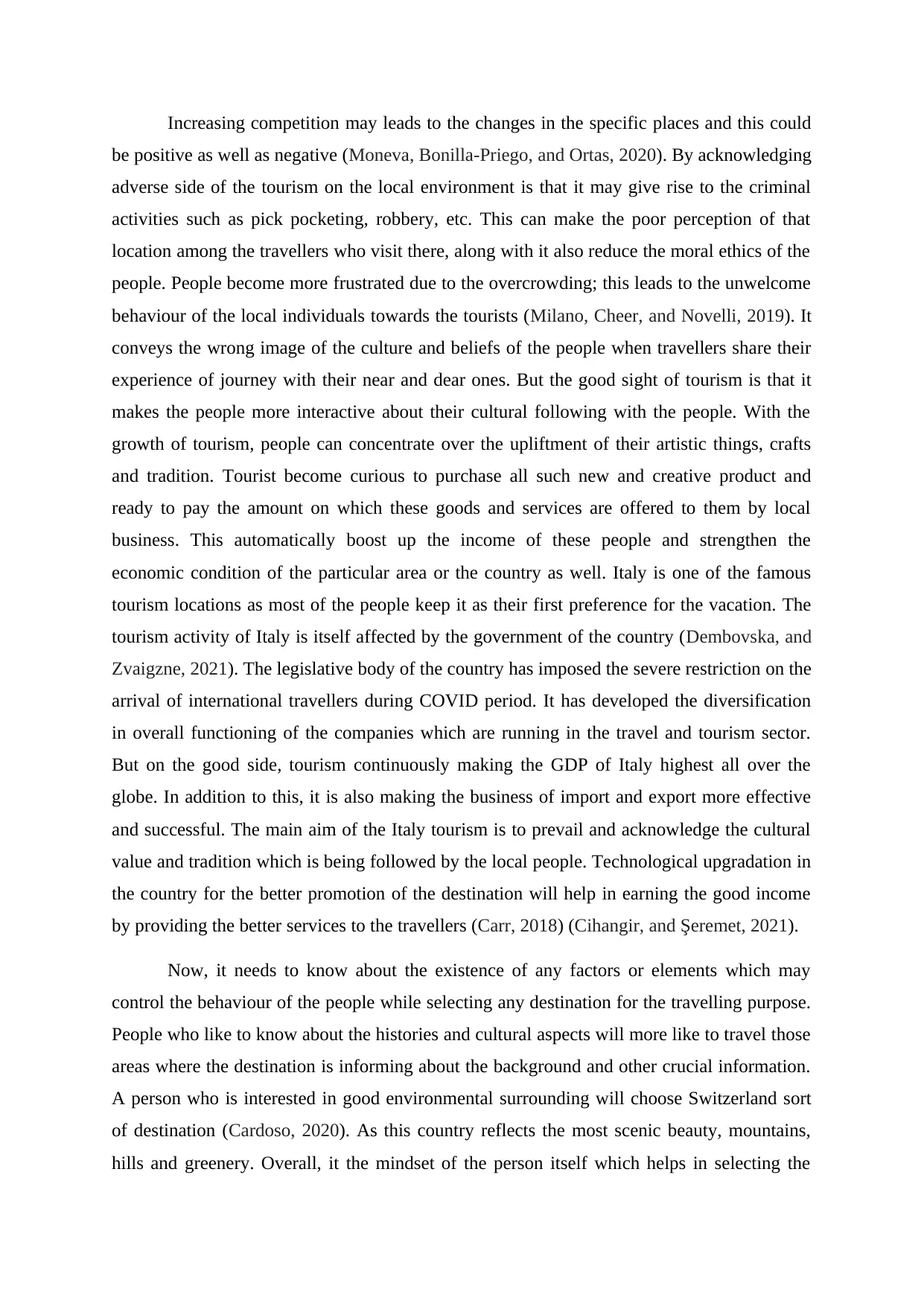
Increasing competition may leads to the changes in the specific places and this could
be positive as well as negative (Moneva, Bonilla-Priego, and Ortas, 2020). By acknowledging
adverse side of the tourism on the local environment is that it may give rise to the criminal
activities such as pick pocketing, robbery, etc. This can make the poor perception of that
location among the travellers who visit there, along with it also reduce the moral ethics of the
people. People become more frustrated due to the overcrowding; this leads to the unwelcome
behaviour of the local individuals towards the tourists (Milano, Cheer, and Novelli, 2019). It
conveys the wrong image of the culture and beliefs of the people when travellers share their
experience of journey with their near and dear ones. But the good sight of tourism is that it
makes the people more interactive about their cultural following with the people. With the
growth of tourism, people can concentrate over the upliftment of their artistic things, crafts
and tradition. Tourist become curious to purchase all such new and creative product and
ready to pay the amount on which these goods and services are offered to them by local
business. This automatically boost up the income of these people and strengthen the
economic condition of the particular area or the country as well. Italy is one of the famous
tourism locations as most of the people keep it as their first preference for the vacation. The
tourism activity of Italy is itself affected by the government of the country (Dembovska, and
Zvaigzne, 2021). The legislative body of the country has imposed the severe restriction on the
arrival of international travellers during COVID period. It has developed the diversification
in overall functioning of the companies which are running in the travel and tourism sector.
But on the good side, tourism continuously making the GDP of Italy highest all over the
globe. In addition to this, it is also making the business of import and export more effective
and successful. The main aim of the Italy tourism is to prevail and acknowledge the cultural
value and tradition which is being followed by the local people. Technological upgradation in
the country for the better promotion of the destination will help in earning the good income
by providing the better services to the travellers (Carr, 2018) (Cihangir, and Şeremet, 2021).
Now, it needs to know about the existence of any factors or elements which may
control the behaviour of the people while selecting any destination for the travelling purpose.
People who like to know about the histories and cultural aspects will more like to travel those
areas where the destination is informing about the background and other crucial information.
A person who is interested in good environmental surrounding will choose Switzerland sort
of destination (Cardoso, 2020). As this country reflects the most scenic beauty, mountains,
hills and greenery. Overall, it the mindset of the person itself which helps in selecting the
be positive as well as negative (Moneva, Bonilla-Priego, and Ortas, 2020). By acknowledging
adverse side of the tourism on the local environment is that it may give rise to the criminal
activities such as pick pocketing, robbery, etc. This can make the poor perception of that
location among the travellers who visit there, along with it also reduce the moral ethics of the
people. People become more frustrated due to the overcrowding; this leads to the unwelcome
behaviour of the local individuals towards the tourists (Milano, Cheer, and Novelli, 2019). It
conveys the wrong image of the culture and beliefs of the people when travellers share their
experience of journey with their near and dear ones. But the good sight of tourism is that it
makes the people more interactive about their cultural following with the people. With the
growth of tourism, people can concentrate over the upliftment of their artistic things, crafts
and tradition. Tourist become curious to purchase all such new and creative product and
ready to pay the amount on which these goods and services are offered to them by local
business. This automatically boost up the income of these people and strengthen the
economic condition of the particular area or the country as well. Italy is one of the famous
tourism locations as most of the people keep it as their first preference for the vacation. The
tourism activity of Italy is itself affected by the government of the country (Dembovska, and
Zvaigzne, 2021). The legislative body of the country has imposed the severe restriction on the
arrival of international travellers during COVID period. It has developed the diversification
in overall functioning of the companies which are running in the travel and tourism sector.
But on the good side, tourism continuously making the GDP of Italy highest all over the
globe. In addition to this, it is also making the business of import and export more effective
and successful. The main aim of the Italy tourism is to prevail and acknowledge the cultural
value and tradition which is being followed by the local people. Technological upgradation in
the country for the better promotion of the destination will help in earning the good income
by providing the better services to the travellers (Carr, 2018) (Cihangir, and Şeremet, 2021).
Now, it needs to know about the existence of any factors or elements which may
control the behaviour of the people while selecting any destination for the travelling purpose.
People who like to know about the histories and cultural aspects will more like to travel those
areas where the destination is informing about the background and other crucial information.
A person who is interested in good environmental surrounding will choose Switzerland sort
of destination (Cardoso, 2020). As this country reflects the most scenic beauty, mountains,
hills and greenery. Overall, it the mindset of the person itself which helps in selecting the
Paraphrase This Document
Need a fresh take? Get an instant paraphrase of this document with our AI Paraphraser
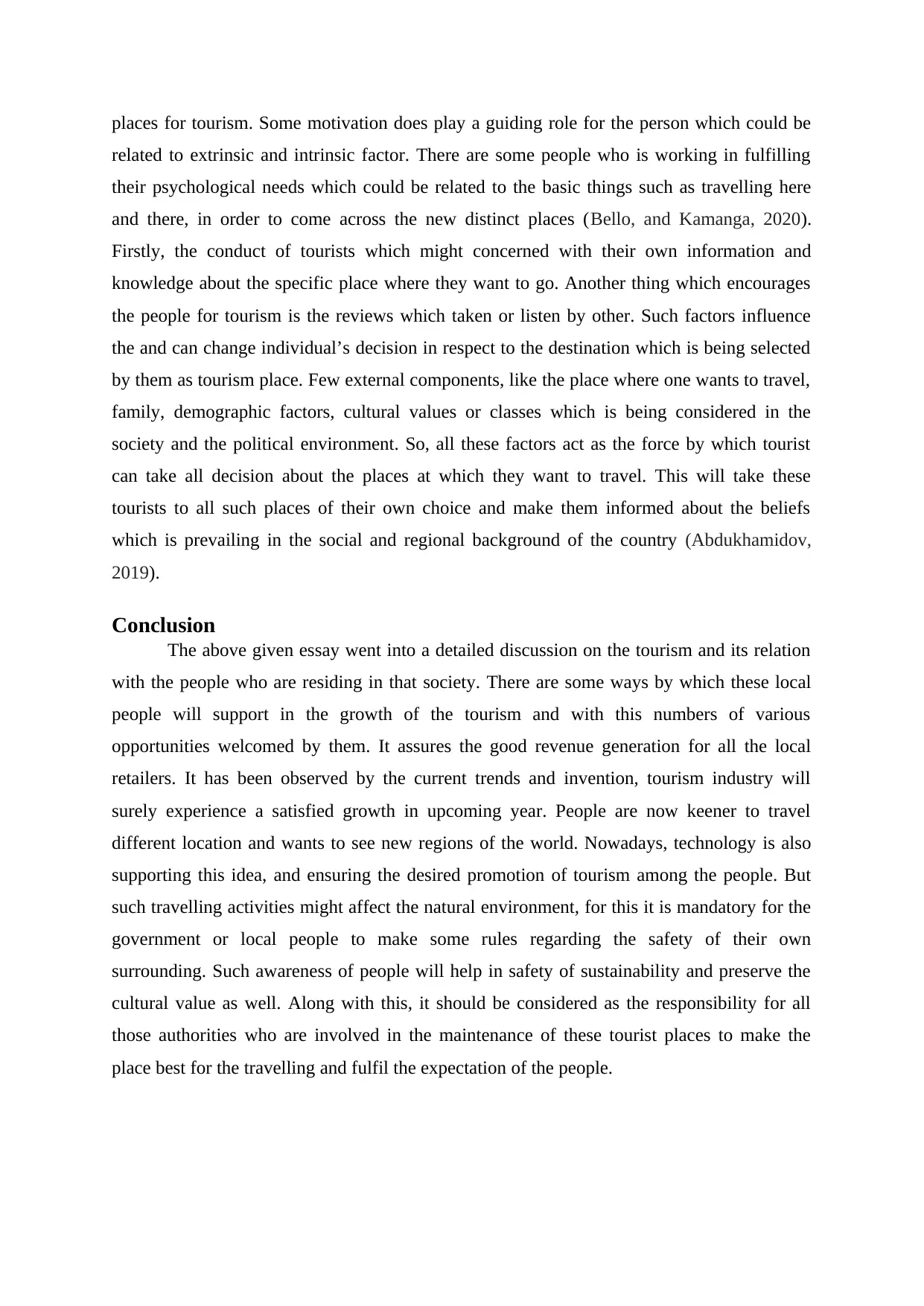
places for tourism. Some motivation does play a guiding role for the person which could be
related to extrinsic and intrinsic factor. There are some people who is working in fulfilling
their psychological needs which could be related to the basic things such as travelling here
and there, in order to come across the new distinct places (Bello, and Kamanga, 2020).
Firstly, the conduct of tourists which might concerned with their own information and
knowledge about the specific place where they want to go. Another thing which encourages
the people for tourism is the reviews which taken or listen by other. Such factors influence
the and can change individual’s decision in respect to the destination which is being selected
by them as tourism place. Few external components, like the place where one wants to travel,
family, demographic factors, cultural values or classes which is being considered in the
society and the political environment. So, all these factors act as the force by which tourist
can take all decision about the places at which they want to travel. This will take these
tourists to all such places of their own choice and make them informed about the beliefs
which is prevailing in the social and regional background of the country (Abdukhamidov,
2019).
Conclusion
The above given essay went into a detailed discussion on the tourism and its relation
with the people who are residing in that society. There are some ways by which these local
people will support in the growth of the tourism and with this numbers of various
opportunities welcomed by them. It assures the good revenue generation for all the local
retailers. It has been observed by the current trends and invention, tourism industry will
surely experience a satisfied growth in upcoming year. People are now keener to travel
different location and wants to see new regions of the world. Nowadays, technology is also
supporting this idea, and ensuring the desired promotion of tourism among the people. But
such travelling activities might affect the natural environment, for this it is mandatory for the
government or local people to make some rules regarding the safety of their own
surrounding. Such awareness of people will help in safety of sustainability and preserve the
cultural value as well. Along with this, it should be considered as the responsibility for all
those authorities who are involved in the maintenance of these tourist places to make the
place best for the travelling and fulfil the expectation of the people.
related to extrinsic and intrinsic factor. There are some people who is working in fulfilling
their psychological needs which could be related to the basic things such as travelling here
and there, in order to come across the new distinct places (Bello, and Kamanga, 2020).
Firstly, the conduct of tourists which might concerned with their own information and
knowledge about the specific place where they want to go. Another thing which encourages
the people for tourism is the reviews which taken or listen by other. Such factors influence
the and can change individual’s decision in respect to the destination which is being selected
by them as tourism place. Few external components, like the place where one wants to travel,
family, demographic factors, cultural values or classes which is being considered in the
society and the political environment. So, all these factors act as the force by which tourist
can take all decision about the places at which they want to travel. This will take these
tourists to all such places of their own choice and make them informed about the beliefs
which is prevailing in the social and regional background of the country (Abdukhamidov,
2019).
Conclusion
The above given essay went into a detailed discussion on the tourism and its relation
with the people who are residing in that society. There are some ways by which these local
people will support in the growth of the tourism and with this numbers of various
opportunities welcomed by them. It assures the good revenue generation for all the local
retailers. It has been observed by the current trends and invention, tourism industry will
surely experience a satisfied growth in upcoming year. People are now keener to travel
different location and wants to see new regions of the world. Nowadays, technology is also
supporting this idea, and ensuring the desired promotion of tourism among the people. But
such travelling activities might affect the natural environment, for this it is mandatory for the
government or local people to make some rules regarding the safety of their own
surrounding. Such awareness of people will help in safety of sustainability and preserve the
cultural value as well. Along with this, it should be considered as the responsibility for all
those authorities who are involved in the maintenance of these tourist places to make the
place best for the travelling and fulfil the expectation of the people.
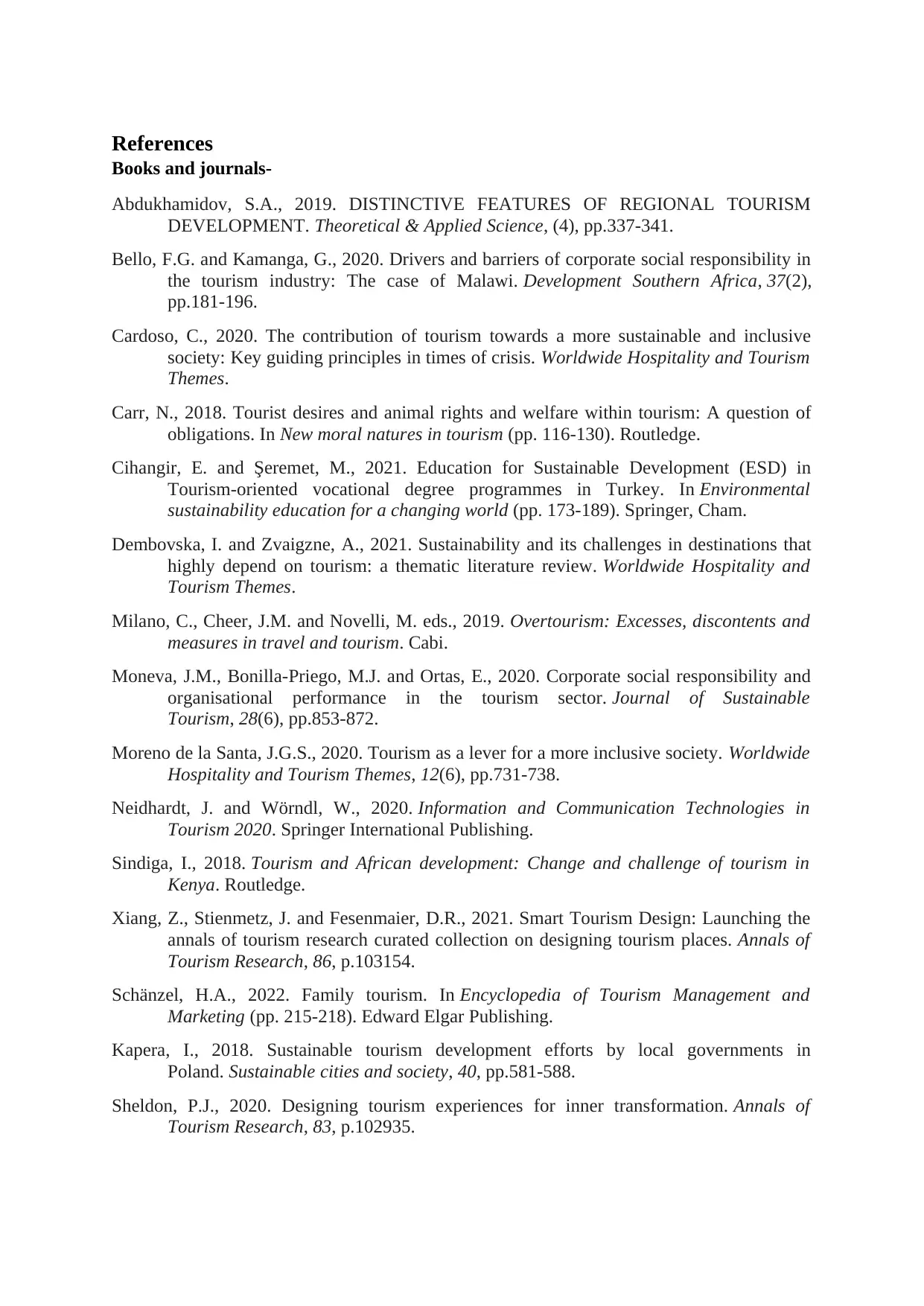
References
Books and journals-
Abdukhamidov, S.A., 2019. DISTINCTIVE FEATURES OF REGIONAL TOURISM
DEVELOPMENT. Theoretical & Applied Science, (4), pp.337-341.
Bello, F.G. and Kamanga, G., 2020. Drivers and barriers of corporate social responsibility in
the tourism industry: The case of Malawi. Development Southern Africa, 37(2),
pp.181-196.
Cardoso, C., 2020. The contribution of tourism towards a more sustainable and inclusive
society: Key guiding principles in times of crisis. Worldwide Hospitality and Tourism
Themes.
Carr, N., 2018. Tourist desires and animal rights and welfare within tourism: A question of
obligations. In New moral natures in tourism (pp. 116-130). Routledge.
Cihangir, E. and Şeremet, M., 2021. Education for Sustainable Development (ESD) in
Tourism-oriented vocational degree programmes in Turkey. In Environmental
sustainability education for a changing world (pp. 173-189). Springer, Cham.
Dembovska, I. and Zvaigzne, A., 2021. Sustainability and its challenges in destinations that
highly depend on tourism: a thematic literature review. Worldwide Hospitality and
Tourism Themes.
Milano, C., Cheer, J.M. and Novelli, M. eds., 2019. Overtourism: Excesses, discontents and
measures in travel and tourism. Cabi.
Moneva, J.M., Bonilla-Priego, M.J. and Ortas, E., 2020. Corporate social responsibility and
organisational performance in the tourism sector. Journal of Sustainable
Tourism, 28(6), pp.853-872.
Moreno de la Santa, J.G.S., 2020. Tourism as a lever for a more inclusive society. Worldwide
Hospitality and Tourism Themes, 12(6), pp.731-738.
Neidhardt, J. and Wörndl, W., 2020. Information and Communication Technologies in
Tourism 2020. Springer International Publishing.
Sindiga, I., 2018. Tourism and African development: Change and challenge of tourism in
Kenya. Routledge.
Xiang, Z., Stienmetz, J. and Fesenmaier, D.R., 2021. Smart Tourism Design: Launching the
annals of tourism research curated collection on designing tourism places. Annals of
Tourism Research, 86, p.103154.
Schänzel, H.A., 2022. Family tourism. In Encyclopedia of Tourism Management and
Marketing (pp. 215-218). Edward Elgar Publishing.
Kapera, I., 2018. Sustainable tourism development efforts by local governments in
Poland. Sustainable cities and society, 40, pp.581-588.
Sheldon, P.J., 2020. Designing tourism experiences for inner transformation. Annals of
Tourism Research, 83, p.102935.
Books and journals-
Abdukhamidov, S.A., 2019. DISTINCTIVE FEATURES OF REGIONAL TOURISM
DEVELOPMENT. Theoretical & Applied Science, (4), pp.337-341.
Bello, F.G. and Kamanga, G., 2020. Drivers and barriers of corporate social responsibility in
the tourism industry: The case of Malawi. Development Southern Africa, 37(2),
pp.181-196.
Cardoso, C., 2020. The contribution of tourism towards a more sustainable and inclusive
society: Key guiding principles in times of crisis. Worldwide Hospitality and Tourism
Themes.
Carr, N., 2018. Tourist desires and animal rights and welfare within tourism: A question of
obligations. In New moral natures in tourism (pp. 116-130). Routledge.
Cihangir, E. and Şeremet, M., 2021. Education for Sustainable Development (ESD) in
Tourism-oriented vocational degree programmes in Turkey. In Environmental
sustainability education for a changing world (pp. 173-189). Springer, Cham.
Dembovska, I. and Zvaigzne, A., 2021. Sustainability and its challenges in destinations that
highly depend on tourism: a thematic literature review. Worldwide Hospitality and
Tourism Themes.
Milano, C., Cheer, J.M. and Novelli, M. eds., 2019. Overtourism: Excesses, discontents and
measures in travel and tourism. Cabi.
Moneva, J.M., Bonilla-Priego, M.J. and Ortas, E., 2020. Corporate social responsibility and
organisational performance in the tourism sector. Journal of Sustainable
Tourism, 28(6), pp.853-872.
Moreno de la Santa, J.G.S., 2020. Tourism as a lever for a more inclusive society. Worldwide
Hospitality and Tourism Themes, 12(6), pp.731-738.
Neidhardt, J. and Wörndl, W., 2020. Information and Communication Technologies in
Tourism 2020. Springer International Publishing.
Sindiga, I., 2018. Tourism and African development: Change and challenge of tourism in
Kenya. Routledge.
Xiang, Z., Stienmetz, J. and Fesenmaier, D.R., 2021. Smart Tourism Design: Launching the
annals of tourism research curated collection on designing tourism places. Annals of
Tourism Research, 86, p.103154.
Schänzel, H.A., 2022. Family tourism. In Encyclopedia of Tourism Management and
Marketing (pp. 215-218). Edward Elgar Publishing.
Kapera, I., 2018. Sustainable tourism development efforts by local governments in
Poland. Sustainable cities and society, 40, pp.581-588.
Sheldon, P.J., 2020. Designing tourism experiences for inner transformation. Annals of
Tourism Research, 83, p.102935.
⊘ This is a preview!⊘
Do you want full access?
Subscribe today to unlock all pages.

Trusted by 1+ million students worldwide

1 out of 7
Related Documents
Your All-in-One AI-Powered Toolkit for Academic Success.
+13062052269
info@desklib.com
Available 24*7 on WhatsApp / Email
![[object Object]](/_next/static/media/star-bottom.7253800d.svg)
Unlock your academic potential
Copyright © 2020–2025 A2Z Services. All Rights Reserved. Developed and managed by ZUCOL.





